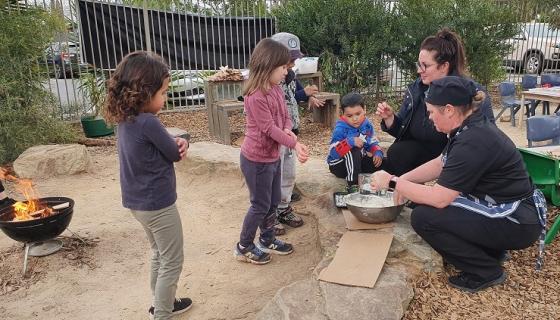
Nature play conversion
A service’s unused front yard has become a place for nature play and reconciliation activities. Mardi Matthew, Centre Director of Wandana Avenue Early Learning & Kinder, explains.
At Wandana we have converted our front unused yard into a nature play space for the children. There are paths leading to a variety of small areas for experiences based around nature and or recycled play. We also have built a mud pit and kitchen area for pretend play.
All materials used are upcycled or natural, such as donated pots and pans, cooking utensils, sticks, herbs, flowers, bark, etc.
Surrounding the yard, we have bushes and cubbies. In one corner we have an old boat, which is a great prop for extending children’s imaginative play. There is also an area we have developed as our yarning circle, and it is a well-used space.
Changing the space
When I started at Wandana in 2019 this area was not being utilised. After much discussion with all stakeholders about the benefits of nature play and the holistic learning that can occur, we brought in our gardeners. We had an in-depth discussion about how to turn our ideas into a safe space that was compliant with the regulations, inviting and engaging and low maintenance. We all worked together and, before long, the space became a useable play area.
Benefits of nature play
I set about educating families, children and the educators about the benefits of a nature play space. This included why this area should use, as best as possible, natural and recycled materials with many loose parts to enhance children’s curiosity and imagination to further support their learning.
I started an inquiry project on this topic to assist in embedding the knowledge and importance of creating open-ended play, with natural or recycled materials, which will allow children to guide their own learning.
A clear understanding of the importance of nature play has encouraged all educators to incorporate the space into their daily programs. Children spend hours exploring and creating, using the yarning circle to tell stories, talk about experiences and to learn about the world.
Bush tucker garden
As part of our reconciliation action plan, we focused on creating a bush tucker garden. We wanted this to be easily available for both families and children, as we want everyone to be a part of nurturing and growing this space.
After much collaboration we built a small garden in front of the nature yard and near the entrance. We left garden tools and bottles of water for anyone to help maintain the garden and to hopefully create connections with our families and children.
Our plan is to extend this garden into the nature play space for children to have direct access to these plants and further develop their connection with the land.
A central learning hub
This play space will continue to evolve and change as we do. Along with new families and educators come new ideas and new directions. We are currently putting forward plans to create climbing and swinging areas using some fixed natural structures.
We all love this nature play space. It has become a central learning hub for our service, and we enjoy organising whole-centre experiences. Our latest is ‘Learning from the land’, where we had nature art and creative experiences set in all spaces of the yard and a fire pit in the middle of the yarning circle. Here we made damper, had our lunch and snacks throughout the day, told stories and just spent time together.
Overall, this area is an amazing space where daily learning occurs. We are proud of our nature yard and the improvements made, and we know that just as our children and educators grow, so will our nature yard.
At Wandana we will continue to advocate for the importance of nature play in the early years.

